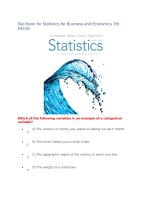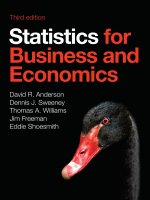Statistics for business economics 7th by paul newbold chapter 03
Bạn đang xem bản rút gọn của tài liệu. Xem và tải ngay bản đầy đủ của tài liệu tại đây (142.64 KB, 40 trang )
Statistics for
Business and Economics
7th Edition
Chapter 3
Probability
Copyright © 2010 Pearson Education, Inc. Publishing as Prentice Hall
Ch. 3-1
Chapter Goals
After completing this chapter, you should be able to:
Explain basic probability concepts and definitions
Use a Venn diagram or tree diagram to illustrate simple
probabilities
Apply common rules of probability
Compute conditional probabilities
Determine whether events are statistically independent
Use Bayes’ Theorem for conditional probabilities
Copyright © 2010 Pearson Education, Inc. Publishing as Prentice Hall
Ch. 3-2
3.1
Important Terms
Random Experiment – a process leading to an
uncertain outcome
Basic Outcome – a possible outcome of a random
experiment
Sample Space – the collection of all possible outcomes
of a random experiment
Event – any subset of basic outcomes from the sample
space
Copyright © 2010 Pearson Education, Inc. Publishing as Prentice Hall
Ch. 3-3
Important Terms
(continued)
Intersection of Events – If A and B are two events in a
sample space S, then the intersection, A ∩ B, is the set
of all outcomes in S that belong to both A and B
S
A
A∩ B
Copyright © 2010 Pearson Education, Inc. Publishing as Prentice Hall
B
Ch. 3-4
Important Terms
(continued)
A and B are Mutually Exclusive Events if they have no
basic outcomes in common
i.e., the set A ∩ B is empty
S
A
Copyright © 2010 Pearson Education, Inc. Publishing as Prentice Hall
B
Ch. 3-5
Important Terms
(continued)
Union of Events – If A and B are two events in a sample
space S, then the union, A U B, is the set of all
outcomes in S that belong to either
A or B
S
A
Copyright © 2010 Pearson Education, Inc. Publishing as Prentice Hall
B
The entire shaded
area represents
AUB
Ch. 3-6
Important Terms
(continued)
Events E1, E2, … Ek are Collectively Exhaustive events
if E1 U E2 U . . . U Ek = S
i.e., the events completely cover the sample space
The Complement of an event A is the set of all basic
outcomes in the sample space that do not belong to A.
The complement is denoted
A
S
A
Copyright © 2010 Pearson Education, Inc. Publishing as Prentice Hall
A
Ch. 3-7
Examples
Let the Sample Space be the collection of all
possible outcomes of rolling one die:
S = [1, 2, 3, 4, 5, 6]
Let A be the event “Number rolled is even”
Let B be the event “Number rolled is at least 4”
Then
A = [2, 4, 6]
Copyright © 2010 Pearson Education, Inc. Publishing as Prentice Hall
and
B = [4, 5, 6]
Ch. 3-8
Examples
(continued)
S = [1, 2, 3, 4, 5, 6]
A = [2, 4, 6]
B = [4, 5, 6]
Complements:
A = [1, 3, 5]
B = [1, 2, 3]
Intersections:
A ∩ B = [4, 6]
Unions:
A ∩ B = [5]
A ∪ B = [2, 4, 5, 6]
A ∪ A = [1, 2, 3, 4, 5, 6] = S
Copyright © 2010 Pearson Education, Inc. Publishing as Prentice Hall
Ch. 3-9
Examples
(continued)
S = [1, 2, 3, 4, 5, 6]
B = [4, 5, 6]
Mutually exclusive:
A and B are not mutually exclusive
A = [2, 4, 6]
The outcomes 4 and 6 are common to both
Collectively exhaustive:
A and B are not collectively exhaustive
A U B does not contain 1 or 3
Copyright © 2010 Pearson Education, Inc. Publishing as Prentice Hall
Ch. 3-10
3.2
Probability
Probability – the chance that an
uncertain event will occur
(always between 0 and 1)
0 ≤ P(A) ≤ 1 For any event A
1
.5
0
Copyright © 2010 Pearson Education, Inc. Publishing as Prentice Hall
Certain
Impossible
Ch. 3-11
Assessing Probability
There are three approaches to assessing the probability of
an uncertain event:
1. classical probability
probability of event A =
NA
number of outcomes that satisfy the event
=
N
total number of outcomes in the sample space
Assumes all outcomes in the sample space are equally likely to occur
Copyright © 2010 Pearson Education, Inc. Publishing as Prentice Hall
Ch. 3-12
Counting the Possible Outcomes
Use the Combinations formula to determine the
number of combinations of n things taken k at a
time
n!
C =
k! (n − k)!
n
k
where
n! = n(n-1)(n-2)…(1)
0! = 1 by definition
Copyright © 2010 Pearson Education, Inc. Publishing as Prentice Hall
Ch. 3-13
Assessing Probability
Three approaches (continued)
2. relative frequency probability
nA
number of events in the population that satisfy event A
=
n
total number of events in the population
the limit of the proportion of times that an event A occurs in a large number of
trials, n
probability of event A =
3. subjective probability
an individual opinion or belief about the probability of occurrence
Copyright © 2010 Pearson Education, Inc. Publishing as Prentice Hall
Ch. 3-14
Probability Postulates
1. If A is any event in the sample space S, then
0 ≤ P(A) ≤ 1
2. Let A be an event in S, and let Oi denote the basic outcomes.
Then
P(A) = ∑ P(Oi )
A
(the notation means that the summation is over all the basic outcomes in A)
3. P(S) = 1
Copyright © 2010 Pearson Education, Inc. Publishing as Prentice Hall
Ch. 3-15
3.3
Probability Rules
The Complement rule:
P(A) = 1− P(A)
i.e., P(A) + P(A) = 1
The Addition rule:
The probability of the union of two events is
P(A ∪ B) = P(A) + P(B) − P(A ∩ B)
Copyright © 2010 Pearson Education, Inc. Publishing as Prentice Hall
Ch. 3-16
A Probability Table
Probabilities and joint probabilities for two
events A and B are summarized in this table:
B
B
A
P(A ∩ B)
P(A ∩ B )
P(A)
A
P(A ∩ B)
P(A ∩ B )
P(A)
P(B)
P( B )
P(S) = 1.0
Copyright © 2010 Pearson Education, Inc. Publishing as Prentice Hall
Ch. 3-17
Addition Rule Example
Consider a standard deck of 52 cards, with four
suits:
♥♣♦♠
Let event A = card is an Ace
Let event B = card is from a red suit
Copyright © 2010 Pearson Education, Inc. Publishing as Prentice Hall
Ch. 3-18
Addition Rule Example
(continued)
P(Red U Ace) = P(Red) + P(Ace) - P(Red ∩ Ace)
= 26/52 + 4/52 - 2/52 = 28/52
Type
Color
Red
Black
Total
Ace
2
2
4
Non-Ace
24
24
48
Total
26
26
52
Copyright © 2010 Pearson Education, Inc. Publishing as Prentice Hall
Don’t count
the two red
aces twice!
Ch. 3-19
Conditional Probability
A conditional probability is the probability of one event,
given that another event has occurred:
P(A ∩ B)
P(A | B) =
P(B)
The conditional
probability of A
given that B has
occurred
P(A ∩ B)
P(B | A) =
P(A)
The conditional
probability of B
given that A has
occurred
Copyright © 2010 Pearson Education, Inc. Publishing as Prentice Hall
Ch. 3-20
Conditional Probability Example
Of the cars on a used car lot, 70% have air
conditioning (AC) and 40% have a CD player
(CD). 20% of the cars have both.
What is the probability that a car has a CD player, given
that it has AC ?
i.e., we want to find P(CD | AC)
Copyright © 2010 Pearson Education, Inc. Publishing as Prentice Hall
Ch. 3-21
Conditional Probability Example
(continued)
Of the cars on a used car lot, 70% have air
conditioning (AC) and 40% have a CD player (CD).
20% of the cars have both.
CD
No CD
Total
AC
.2
.5
.7
No AC
.2
.1
.3
Total
.4
.6
1.0
P(CD ∩ AC) .2
P(CD | AC) =
= = .2857
P(AC)
.7
Copyright © 2010 Pearson Education, Inc. Publishing as Prentice Hall
Ch. 3-22
Conditional Probability Example
(continued)
Given AC, we only consider the top row (70% of the cars). Of
these, 20% have a CD player. 20% of 70% is 28.57%.
CD
No CD
Total
AC
.2
.5
.7
No AC
.2
.1
.3
Total
.4
.6
1.0
P(CD ∩ AC) .2
P(CD | AC) =
= = .2857
P(AC)
.7
Copyright © 2010 Pearson Education, Inc. Publishing as Prentice Hall
Ch. 3-23
Multiplication Rule
Multiplication rule for two events A and B:
P(A ∩ B) = P(A | B) P(B)
also
P(A ∩ B) = P(B | A) P(A)
Copyright © 2010 Pearson Education, Inc. Publishing as Prentice Hall
Ch. 3-24
Multiplication Rule Example
P(Red ∩ Ace) = P(Red| Ace)P(Ace)
2 4 2
= =
4 52 52
number of cards that are red and ace
2
=
=
total number of cards
52
Type
Color
Red
Black
Total
Ace
2
2
4
Non-Ace
24
24
48
Total
26
26
52
Copyright © 2010 Pearson Education, Inc. Publishing as Prentice Hall
Ch. 3-25









